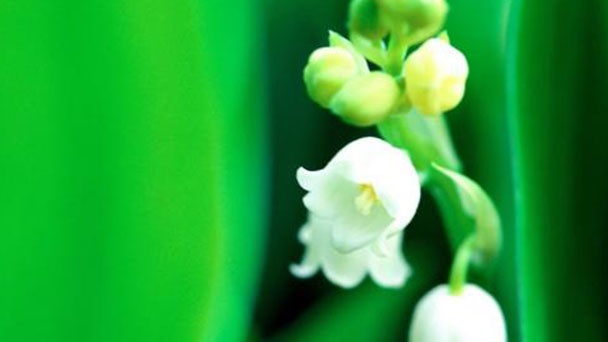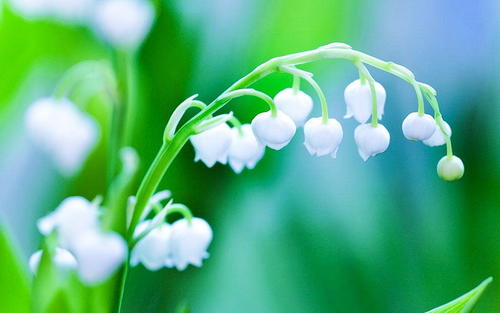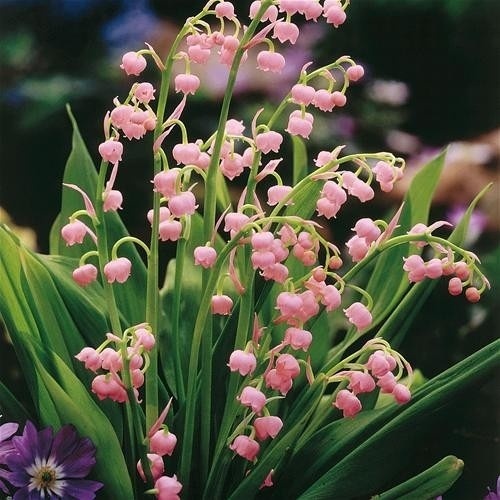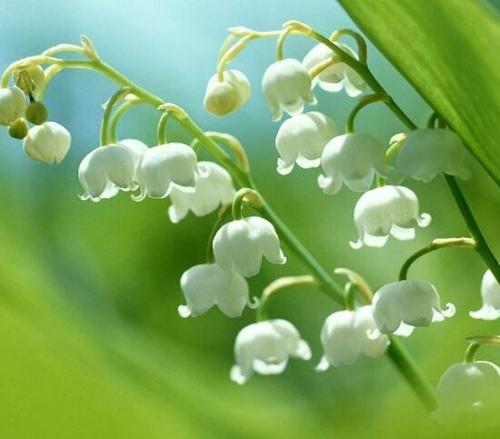Lily of the valley profile
Written by Maggie
Sep 11 2021

Lily of the valley, scientific name Convallaria majalis, is the only species in the genus Lily of the Valley. Native to the northern hemisphere temperate zone, Europe, Asia and North America and China's northeast, north China are 850 ~ 2500 places are wild distribution. Lily of the valley is one of the top 10 most beautiful flowers in the world.
Lily of the valley picture
Lily of the valley morphological characteristics
Lily of the valley is a perennial herb, the plants are all glabrous, 18-30 cm high, and often grow in pieces. Leaves are elliptic or ovate-lanceolate, 7 -- 20 cm long, 3 -- 8.5 cm wide, apex subacute, base cuneate;Petiole 8-20 cm long.
The scape is 15 -- 30 cm tall, slightly curved; Bracts are lanceolate, shorter than pedicels; Pedicels are 6 -- 15 mm long, subapical related, fruit detached from joints when ripe; Flowers are white, 5-7 mm long and 7 mm wide; Lobes are ovate-triangular, apex acute, 1-veined; Filaments are slightly shorter than anthers, enlarged toward base, anthers sub rectangular; Style is stellate, 2.5 -- 3 mm long. Berries are 6-12 mm in diameter, red when ripe, slightly pendulous.
Seeds are oblate or biconvex, surface finely reticulated, 3 mm in diameter. Flowering period is from May to June, fruiting period from July to September
Lily of the valley growth habit
Lily of the valley likes half shade, moist environment, good cool, avoid hot and dry, cold resistance, rich in humus loam and sandy loam requirements. Lily of the valley grows shade slopes under the forest moist or ditch, 850 ~ 2500 meters above sea level.
Lily of the valley propagation methods
Propagation is often divided into rhizomes or buds. Autumn on the ground after the wither dig up the rhizome, take the bud of the end of the stem sub-plant planting. Large buds can flower after dividing the next spring, while small ones need to flower one year later.
Lily of the valley growing methods
It is better to plough the land deep and fertile. After 3 ~ 4 years, change the ground to plant again, or rotate with other flowers. Planting Lily of the valley row spacing 25 ~ 30 cm, each cluster 2 ~ 3 buds, covering soil depth 5 ~ 6 cm. During the growing period, the soil should be kept loose and moist, and a fully fermented topdressing should be applied in early spring and late autumn. With adequate sunshine before flowering, flower after more resistant to shade, autumn leaves, for forcing culture, cut take root cap, and buy 2 ~ 3 degrees Celsius indoor, low temperature by 2 to 3 weeks treatment, take out the basin lee to shade, five weeks before the flowering into 12 ~ 14 degrees Celsius in the greenhouse, proper water and the dark, after 10 ~ 15 days to light, room temperature rose to 20 degrees Celsius, the bottom temperature of 22 degrees Celsius, and increase the water and fertilizer, after 3 weeks can blossom. Propetent cultivation often does not germinate in the absence of low temperature and darkness, or if germinated, the scapes and leaves grow irregularly, hindering the ornamental appearance.

Lily of the valley diseases and insect pests control
If there is brown spot, spray with 75% chlorothalonil wettable powder 700 times liquid.
Lily of the Valley main usage
Lily of the Valley can use whole grass as medicine. The Lily of the valley is small, elegant and fragrant, making it an excellent ground cover and potted plant. There are milky white, pink and variegated varieties.In autumn, the red fruits are very attractive
The Lily of the Valley and the lilac cannot be put together, otherwise the lilac will wilt rapidly, even 20 centimeters apart. If the Lily of the Valley is removed, the lilac will return to its original state .Lily of the valley can not be put with the daffodils, otherwise it will lose both sides.
Lily of the valley flower language
Lily of the Valley represents the arrival of happiness. It is the national flower of Finland, Sweden and Yugoslavia. In the French wedding you can often see, sending this kind of flower to the bride, is to congratulate the arrival of the new happiness. Perhaps it's because the flowers, shaped like little bells, are reminiscent of little bells that evoke happiness. In friendship, Lily of the Valley has always expressed the pride of "happiness, purity and virginity" and the good wishes of "happiness bestowed on pure girls".

Latest Updated
- Benefits of Bugleweed - 7 Science-backed Health Benefits
- Bugleweed Dangers & Side Effects - Is It Poisonous?
- How to Plant Evergreen Trees - What You Should Know
- When to Plant Evergreens - Grow Guide for Evergreen Trees
- 12 Wonderful Evergreen Shrubs for Your Garden
- 12 Popular Evergreen Plants with Pictures for Beginners
- When And How To Prune A Lilac Bush Like a Pro
- How to Grow & Care for Lilac Vine (Hardenbergia Violacea)
- Japanese Lilac Tree (Syringa Reticulata) Care & Propagation Guide
- Shumard Oak Pros and Cons - What to Know
Popular Articles
- Winter maintenance of Antirrhinum Majus
- How to Grow Terminalia Mantaly Tree
- How to Grow and Care for Crossostephium Chinense
- How to grow Antirrhinum Majus in spring
- Peristeria Elata (Dove Orchid) Profile: Info & Care Guide
- Underwatered Snake Plant (Sansevieria Trifasciata) - Signs And How To Fix
- How to Care for Brazilian Jasmine Plant (Mandevilla Sanderi)
- How to Grow & Care for Graptopetalum Purple Delight in Summer
- Rosa Chinensis (China Rose): Plant Growing & Care Tips
- How to Care for Baby Sun Rose (Aptenia Cordifolia)
